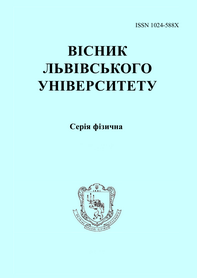DOI: https://doi.org/10.30970/vph.57.2020.46
Temperature study of structural transformation in \beta-LiNH4SO4 crystal
M.Ya. Rudysh, P.A. Shchepanskyi, V.Yo. StadnykR.S. Brezvin

| Visnyk of the Lviv University. Series Physics
57 (2020) ñ. 46-55
DOI: https://doi.org/10.30970/vph.57.2020.46 Temperature study of structural transformation in \beta-LiNH4SO4 crystalM.Ya. Rudysh, P.A. Shchepanskyi, V.Yo. StadnykR.S. Brezvin |  |
The LiNH4SO4 dielectric single crystal of \beta-polymorphic modification was synthesized by the method of slow evaporation of the aqueous solution at constant temperature of 308 K. Chemically pure salts of lithium sulfate (Li2SO4) and ammonium sulfate ((NH4)2SO4) in an equimolar ratio were used as the starting reagents. In a result the optically homogeneous transparent crystals with a volume of approximately 3 cm3 were obtained. In order to identify the grown crystals the X-ray diffraction studies were performed. The obtained structure was refined by the Rietveld method. Parameters such as peak asymmetry, absorption, texture, displacement, etc. were taken into account during the refinement. The crystal was confirmed to belong to the \beta-modification with orthorhombic symmetry of Pna21 space group symmetry (No 33). The obtained lattice parameters are as follows: a = 8.7739(3) \mathring{\mathrm{A}}, b = 9.1286(4) \mathring{\mathrm{A}}, c = 5.2788(2) \mathring{\mathrm{A}} and V = 422.80(5) \mathring{\mathrm{A}}3. In order to study the structural transformations, the investigation of the birefringence dispersion of the crystal in the temperature range of 300–530 K was performed. It was found that the birefringence of the crystal is quite sensitive to temperature changes. The birefringences in X- and Y-directions decrease with temperature increase with the rate of –0.221 \cdot 10–4 K–1 and –0.124 \cdot 10–4 K–1, respectively, while in Z-direction it monotonically increases with the rate of 0.099 \cdot 10–4 K–1. At the temperature of approximately Tc = 461 K the phase transition of the second order takes place. This phase transition corresponds to the transformation of the crystal structure from symmetry mm2 to mmm and characterizes the transition of the crystal from ferroelectric to paraelectric phase. At temperatures above 461 K the birefringence curves for all three directions slightly change the course. In order to confirm the presence of the phase transition in the \beta-LiNH4SO4 crystal during heating, we performed the differential thermal analysis using the simultaneous LINSEIS STA PT 1600 thermal analyzer. The DTA results confirmed the presence of the phase transformation in the \beta-LiNH4SO4 crystal.